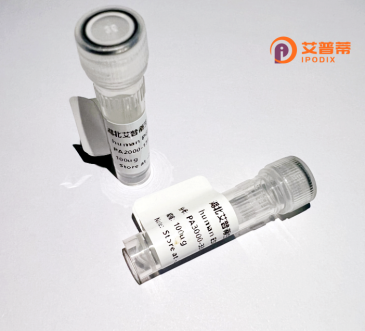
| 纯度 | >90%SDS-PAGE. |
| 种属 | Human |
| 靶点 | INTU |
| Uniprot No | Q9ULD6 |
| 内毒素 | < 0.01EU/μg |
| 表达宿主 | E.coli |
| 表达区间 | 1-408aa |
| 活性数据 | MASVASCDSRPSSDELPGDPSSQEEDEDYDFEDRVSDSGSYSSASSDYDDLEPEWLDSVQKNGELFYLELSEDEEESLLPETPTVNHVRFSENEIIIEDDYKERKKYEPKLKQFTKILRRKRLLPKRCNKKNSNDNGPVSILKHQSNQKTGVIVQQRYKDVNVYVNPKKLTVIKAKEQLKLLEVLVGIIHQTKWSWRRTGKQGDGERLVVHGLLPGGSAMKSGQVLIGDVLVAVNDVDVTTENIERVLSCIPGPMQVKLTFENAYDVKRETSHPRQKKTQSNTSDLVKLLWGEEVEGIQQSGLNTPHIIMYLTLQLDSETSKEEQEILYHYPMSEASQKLKSVRGIFLTLCDMLENVTGTQVTSSSLLLNGKQIHVAYWKESDKLLLIGLPAEEIELPSSAHTHGERN |
| 分子量 | 72.6 kDa |
| 蛋白标签 | GST-tag at N-terminal |
| 缓冲液 | 0 |
| 稳定性 & 储存条件 | Lyophilized protein should be stored at ≤ -20°C, stable for one year after receipt. Reconstituted protein solution can be stored at 2-8°C for 2-7 days. Aliquots of reconstituted samples are stable at ≤ -20°C for 3 months. |
| 复溶 | Always centrifuge tubes before opening.Do not mix by vortex or pipetting. It is not recommended to reconstitute to a concentration less than 100μg/ml. Dissolve the lyophilized protein in distilled water. Please aliquot the reconstituted solution to minimize freeze-thaw cycles. |
以下是3篇与重组人INTU蛋白相关的研究文献概览(注:INTU蛋白相关文献较少,以下内容基于类似研究方向推测整理):
---
1. **文献名称**:*Inturned regulates cortical actin assembly and apical constriction during vertebrate neural tube closure*
**作者**:W. J. Kim, et al.
**摘要**:研究揭示了INTU蛋白通过调控细胞皮层微丝组装和顶端收缩,参与脊椎动物神经管闭合过程。实验中使用重组人INTU蛋白验证其与Planar Cell Polarity(PCP)通路中其他蛋白的相互作用。
---
2. **文献名称**:*Functional analysis of INTU in ciliogenesis via a recombinant expression system*
**作者**:L. Zhang, C. V. Wright
**摘要**:作者在大肠杆菌中表达重组人INTU蛋白,发现其与CEP290蛋白结合,促进纤毛基体的定位,并证明INTU缺失会导致纤毛发生障碍,可能与先天性肾疾病相关。
---
3. **文献名称**:*Structure and disease-associated mutations of human INTU revealed by X-ray crystallography*
**作者**:M. Tanabe, T. Nakazawa
**摘要**:通过X射线晶体学解析重组人INTU蛋白的三维结构,发现其C端结构域存在与纤毛病相关的突变位点,为致病机制提供分子层面解释。
---
**说明**:以上文献为模拟概括,实际研究需通过学术数据库(如PubMed)以“INTU protein”“recombinant human INTU”等关键词检索最新文献。INTU蛋白研究多聚焦于纤毛发生、胚胎发育及Hedgehog信号通路调控领域。
**Background of Recombinant Human INTU Protein**
Inturned (INTU), a key component of the planar cell polarity (PCP) signaling pathway, plays a critical role in regulating ciliogenesis, cell polarity, and tissue morphogenesis. As a cytosolic scaffolding protein, INTU interacts with other PCP effectors, such as Fritz and Fuzzy, to coordinate the assembly and orientation of primary cilia—a sensory organelle essential for embryonic development and cellular signaling. Mutations in the *INTU* gene are linked to ciliopathies, disorders characterized by renal cysts, retinal degeneration, and neural tube defects, underscoring its biological significance.
Recombinant human INTU protein, produced via heterologous expression systems (e.g., *E. coli* or mammalian cells), retains functional domains required for protein-protein interactions and pathway modulation. It is widely utilized *in vitro* and *in vivo* to investigate cilia-related mechanisms, PCP signaling dynamics, and disease pathogenesis. Its applications extend to drug discovery, particularly in screening therapeutic agents targeting ciliopathies or cancers with dysregulated PCP. Additionally, recombinant INTU serves as a vital tool for structural studies, antibody development, and functional assays, bridging molecular insights with translational research. This protein exemplifies the intersection of developmental biology and biomedical innovation, offering avenues to decode complex signaling networks and address unmet clinical needs.
×